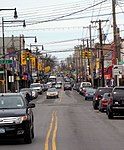St. Agnes Academic High School (Queens)

St. Agnes Academic High School is an all-girls, private, Roman Catholic high school in Queens, New York. It is located within the Roman Catholic Diocese of Brooklyn, and was established in 1908 by the Sisters of St. Dominic.St. Agnes held its first graduation for 6 students in 1912. The school was originally co-educational, but shifted its focus to all-girls education in the aftermath of the Second World War. The current building was built in 1958. St. Agnes is affiliated with the Catholic University of America, Washington, D.C., and is accredited by the Middle States Association of Colleges and Schools. The school was closed in June 2021 due to financial hardships.
Excerpt from the Wikipedia article St. Agnes Academic High School (Queens) (License: CC BY-SA 3.0, Authors, Images).St. Agnes Academic High School (Queens)
124th Street, New York Queens
Geographical coordinates (GPS) Address Nearby Places Show on map
Geographical coordinates (GPS)
| Latitude | Longitude |
|---|---|
| N 40.785833333333 ° | E -73.844166666667 ° |
Address
Saint Agnes Academy High School
124th Street 13-20
11356 New York, Queens
New York, United States
Open on Google Maps









